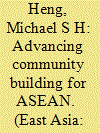| Srl | Item |
| 1 |
ID:
145146


|
|
|
|
|
| Summary/Abstract |
This is a policy paper supporting the vision of ASEAN leaders in the project of ASEAN Community building. However, it goes beyond their declarations to argue for a more thorough going adoption of the norms of the United Nations and to promote more people-to-people activities and ASEAN consciousness among the people. ASEAN was established in 1967 with the aim to strengthen regional cooperation to deal with the geopolitical challenges of the Cold War. It has scored successes in the realm of economy. Driven by the dynamics of globalization, ASEAN has aspired to become a full-fledged community of nations. It aims to widen its scope to include social and cultural dimensions, social justice, and human rights. The most progressive manifestation of this is the ASEAN Charter. To advance the project of the ASEAN Community, this paper makes suggestions at two levels, namely the level of ideas and the level of activities, with some reflections on nation building. A nation at peace with itself based on social justice and human rights contributes to regional community building. If and when it does come about, the ASEAN Community will represent a new ASEAN identity, with a new moral and political order, and it will be able to articulate global issues in international forums with moral authority and moral coherence.
|
|
|
|
|
|
|
|
|
|
|
|
|
|
|
|
| 2 |
ID:
157760


|
|
|
|
|
| Summary/Abstract |
Recent security challenges in East Asia have provided an opportunity to realize the
need for community building as a way of detouring military deadlock. This paper
suggests two principles of community building in East Asia: (1) identity balanced
by interest, and (2) an Asia of citizens beyond an Asia of states. These principles can
be applied to the community building sub-areas of politico–economic, security, and
sociocultural cooperation. The author examines the following topics accordingly:
(a) an invalid concept of the “Asian paradox” and the statement made by Japan’s
prime Minister Shinzo Abe in the politico–economic area; (b) the Helsinki Accord
and the EU Global strategy with their implication for East Asia in the security area;
and (c) the Campus Asia program and the Asian Human Rights Court as a means to
encourage sociocultural cooperation. With its complicated history of animosity and
low levels of intraregional trade, fostering a shared identity and finding common
interests in East Asia is no easy task. If some identities are given and others are
chosen, it is important to manage the negative effects of identity and encourage the
positive influence of its chosen dimensions.
|
|
|
|
|
|
|
|
|
|
|
|
|
|
|
|
| 3 |
ID:
075382


|
|
|
|
|
| Publication |
2006.
|
| Summary/Abstract |
The rise of China is certain to have a great impact on the direction East Asian regionalism takes. In that rapidly evolving process, China will play a major role in integrating with the region. Chin's rise is an opportunity for East Asian community building, because China has been a responsible participant in the community-building process. On the other hand, China's growing power and influence in East Asia could also arouse fear and anxiety, especially in China's neighborhood, which could hamper the process of community building in East Asia.
|
|
|
|
|
|
|
|
|
|
|
|
|
|
|
|